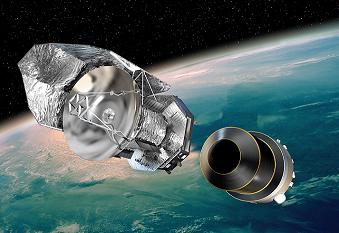While the media has been busy with the launch of the STS-125 Atlantis for the Hubble Servicing Mission #4 from Cape Canaveral, another exciting launch is undergoing preparations further south, in Kourou, French Guiana.
Herschel and Planck are scheduled to launch on May 14, 2009. They will be stacked on the same Ariane 5 launch vehicle.
The two spacecraft will separate shortly after the launch (Herschel a couple of minutes before Planck) and will proceed independently to the L2 point of the Sun-Earth system. L2 is a point in space that has some special characteristics situated at 1.5 million kilometers from Earth in the opposite direction to the Sun. Herschel and Planck will operate from independent orbits around the L2 point.
Stacked together, Herschel and Planck measure around 11 m in length, 4.5 m in diameter, and have a mass of approximately 5,700 kg. The piece that holds them together is called Sylda. Sylda is a support structure for Herschel and forms a protective cover for Planck.
The final orbit for Herschel will be a large, 900×500-thousand km, Lissajous orbit around the L2. There are three trajectory-correction maneuvers (TCM) planned for Herschel, during days L+1, L+2, and L+12. Planck will require a total of 5 TCMs that will enable it to operate from a 300×200-thousand km Lissajous orbit also around the L2 point.
The Lissajou orbits are inherently unstable, so both spacecraft will need regular thruster burns throughout their missions to stay on track.
“Without regular trajectory corrections, they would naturally drift off into a useless orbit about the Sun or Earth, with the rate of drift increasing with time,” says Gottlob Gienger, the senior flight dynamics advisor for the Herschel and Planck missions.
To read more about the launch of Herschel and Planck, you can visit the dedicated page on ESA’s website.














 Subscribe to our RSS feed
Subscribe to our RSS feed












There are no comments.
Add A Comment